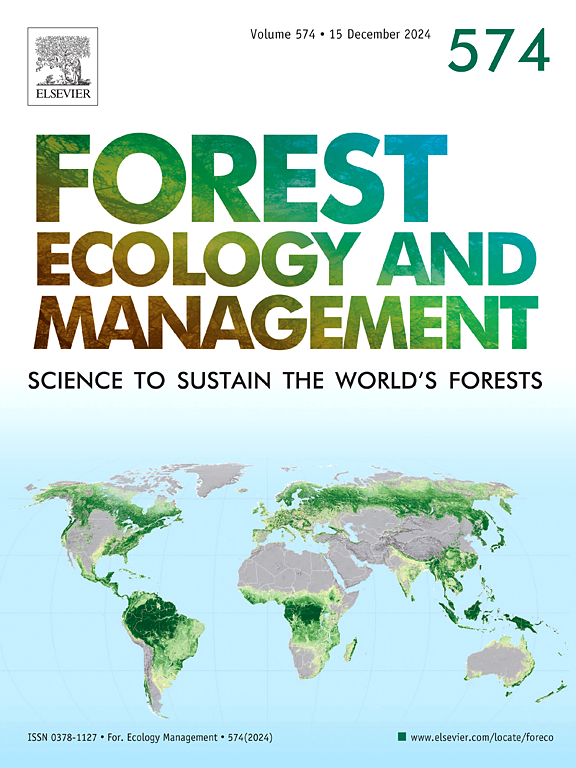将个体和物种水平的叶片特征与个体发生大小联系起来,以解释树木在竞争和环境背景下的表现
IF 3.7
2区 农林科学
Q1 FORESTRY
引用次数: 0
摘要
建立功能性状与树木性能之间的关系是了解森林生态系统动态的关键。然而,在复杂的环境条件下,个体和物种特征如何共同影响树木的生长和生存仍然是一个有争议的话题。为了澄清这一问题,我们分析了2010年至2020年温带自然森林中17个物种1320棵树的叶片特征,建立了个体和物种水平的生长和生存模型。这些性状与个体发育大小、竞争、地形和土壤性质有关,以阐明树木性能的驱动因素。结果表明,物种水平性状调节了大小和环境因子对生长的影响。而个体水平性状则介导了大小、竞争和环境条件对树木性能的影响。本研究为温带森林生态系统中基于性状的研究提供了新的见解,该研究利用成熟的天然林来确定物种和个体性状与个体发育大小、竞争和环境变量相互作用的机制,以解释树木的表现。本文章由计算机程序翻译,如有差异,请以英文原文为准。
Linking individual- and species-level leaf traits with ontogenetic size to explain tree performance within competitive and environmental contexts
Establishing the relationship between functional traits and tree performance is critical to understanding forest ecosystem dynamics. However, how individual and species traits work together to influence tree growth and survival under complex environmental conditions remains a topic of debate. To clarify this issue, we analyzed leaf traits from 1320 individual trees of 17 species within a stem-mapped temperate natural forest to develop growth and survival models at both individual and species levels from 2010 to 2020. These traits were linked to ontogenetic size, competition, topography and soil properties to elucidate the drivers of tree performance. Our results showed that species-level traits moderated the influence of size and environment factors on growth., while individual-level traits mediated the effects of size, competition, and environmental conditions on tree performance. Providing new insights for trait-based studies in temperate forest ecosystems, this study uses mature natural forests to identify mechanisms by which species and individual traits interact with ontogenetic size, competition and environmental variables to explain tree performance.
求助全文
通过发布文献求助,成功后即可免费获取论文全文。
去求助
来源期刊

Forest Ecology and Management
农林科学-林学
CiteScore
7.50
自引率
10.80%
发文量
665
审稿时长
39 days
期刊介绍:
Forest Ecology and Management publishes scientific articles linking forest ecology with forest management, focusing on the application of biological, ecological and social knowledge to the management and conservation of plantations and natural forests. The scope of the journal includes all forest ecosystems of the world.
A peer-review process ensures the quality and international interest of the manuscripts accepted for publication. The journal encourages communication between scientists in disparate fields who share a common interest in ecology and forest management, bridging the gap between research workers and forest managers.
We encourage submission of papers that will have the strongest interest and value to the Journal''s international readership. Some key features of papers with strong interest include:
1. Clear connections between the ecology and management of forests;
2. Novel ideas or approaches to important challenges in forest ecology and management;
3. Studies that address a population of interest beyond the scale of single research sites, Three key points in the design of forest experiments, Forest Ecology and Management 255 (2008) 2022-2023);
4. Review Articles on timely, important topics. Authors are welcome to contact one of the editors to discuss the suitability of a potential review manuscript.
The Journal encourages proposals for special issues examining important areas of forest ecology and management. Potential guest editors should contact any of the Editors to begin discussions about topics, potential papers, and other details.
 求助内容:
求助内容: 应助结果提醒方式:
应助结果提醒方式:


